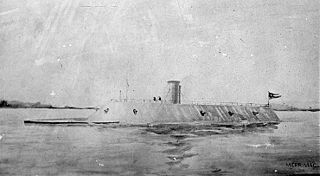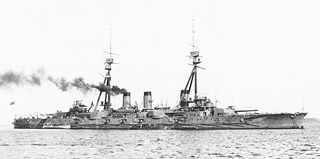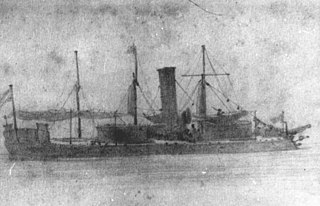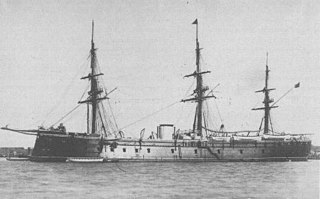
CSS Virginia was the first steam-powered ironclad warship built by the Confederate States Navy during the first year of the American Civil War; she was constructed as a casemate ironclad using the razéed original lower hull and engines of the scuttled steam frigate USS Merrimack. Virginia was one of the participants in the Battle of Hampton Roads, opposing the Union's USS Monitor in March 1862. The battle is chiefly significant in naval history as the first battle between ironclads.

An ironclad is a steam-propelled warship protected by iron or steel armor plates, constructed from 1859 to the early 1890s. The ironclad was developed as a result of the vulnerability of wooden warships to explosive or incendiary shells. The first ironclad battleship, Gloire, was launched by the French Navy in November 1859 - narrowly pre-empting the British Royal Navy.

Kōtetsu, later renamed Azuma, was the first ironclad warship of the Imperial Japanese Navy. She was designed as an armored ram for service in shallow waters, but also carried three guns. The ship was built in Bordeaux, France, for the Confederate States Navy under the cover name Sphinx, but was sold to Denmark after sales of warships by French builders to the Confederacy was forbidden in 1863. The Danes refused to accept the ship and sold her to the Confederates which commissioned her as CSS Stonewall in 1865. The ship did not reach Confederate waters before the end of the American Civil War in April and was turned over to the United States.

CSS Columbia was an ironclad steamer ram in the Confederate States Navy and later in the United States Navy.

Settsu (摂津) was the second and last of the Kawachi-class dreadnought battleships built for the Imperial Japanese Navy (IJN) in the first decade of the 20th century. Following the Japanese ship-naming conventions, Settsu was named after Settsu Province, now a part of Osaka prefecture. During World War I she bombarded German fortifications at Tsingtao during the Battle of Tsingtao in 1914, but saw no other combat. She was placed in reserve in 1919 and was disarmed in 1922 in accordance with the terms of the Washington Naval Treaty.

USS Catawba was a single-turreted Canonicus-class monitor built for the Union Navy during the American Civil War. Completed shortly after the end of the war, Catawba was laid up until sold to her builders in 1868, and then resold to the Peruvian Navy. Renamed BAP Atahualpa, the ship participated in the defense of main port of Peru, Callao, during the War of the Pacific. When the city of Lima was taken by Chilean troops in 1881, she was scuttled to prevent her capture. Atahualpa was later refloated and used as a storage hulk until scrapped in the early 20th century.

CSS Muscogee was an casemate ironclad built in Columbus, Georgia for the Confederate States Navy during the American Civil War. Her original paddle configuration was judged a failure when she could not be launched on the first attempt in 1864. She had to be rebuilt to use dual propeller propulsion. Later renamed CSS Jackson and armed with four 7-inch (178 mm) and two 6.4-inch (163 mm) cannons. She was captured while still fitting out and was set ablaze by Union troops in April 1865. Her wreck was salvaged in 1962–1963 and turned over to the National Civil War Naval Museum in Columbus for display. The ironclad's remains were listed on the National Register of Historic Places in 1970.

The French ironclad Richelieu was a wooden-hulled central battery ironclad built for the French Navy in the early 1870s. She was named after the 17th century statesman Cardinal de Richelieu. The ship was the flagship of the Mediterranean Squadron for most of her career. Richelieu caught on fire in Toulon in 1880 and was scuttled to prevent her magazines from exploding. She was salvaged and, after being repaired, resumed her role as flagship. In 1886, however, the ship was placed in reserve and was eventually condemned in 1901. While being towed to the ship breakers in Amsterdam in 1911, Richelieu was caught in a storm in the Bay of Biscay and had to be cast loose from her tugboat. Nevertheless, the ship survived the storm and was recovered near the Scilly Isles from where she was towed to her final destination.

The Brazilian monitor Bahia was originally ordered by Paraguay in 1864 with the name Minerva, but was sold to Brazil when Paraguay defaulted on the payments. She participated in the 1864–70 War of the Triple Alliance between Brazil, Argentina and Uruguay against Paraguay, and took part in the Passage of Humaitá.

The Brazilian ironclad Lima Barros was originally ordered by Paraguay in 1864 with the name Belona, but was sold to Brazil when Paraguay could not make the final payments. She participated in the 1864–70 Paraguayan War between Brazil, Argentina and Uruguay against Paraguay.

The Brazilian ironclad Silvado was originally ordered by Paraguay in 1864 with the name Nemesis, but was sold to Brazil when Paraguay could not make the final payments. She participated in the 1864–70 War of the Triple Alliance between Brazil, Argentina and Uruguay against Paraguay.

The Spanish ironclad Numancia was an armored frigate bought from France during the 1860s for service with the Royal Spanish Navy. The name was derived from the Siege of Numantia, in which Roman expansion in the Iberian Peninsula was resisted. She was the first ironclad to circumnavigate the Earth. She saw service in the Chincha Islands War and Cantonal Revolution.

The Spanish ironclad Tetuán was an armored frigate built in the royal dockyard at Ferrol during the 1860s for the Spanish Navy. She was captured by rebels during the Cantonal Revolution in 1873 and participated in the Battle off Cartagena. While under repair after the battle, the ship was destroyed by fire and broken up in 1874.

The Spanish ironclad Vitoria was an iron-hulled armored frigate purchased from England during the 1860s. The ship participated on both sides during the Cantonal rebellion of 1873–1874, first on the rebel side and then after her crew surrendered to neutral warships, on the government side. She played a major role in the Battle off Cartagena for the government. Vitoria bombarded rebel towns from 1874 to 1876 during the Third Carlist War. The ship was reconstructed in the late 1890s and reclassified as a coast-defense ship, although she served as a training ship until she was scrapped in 1912.

The Spanish ironclad Sagunto was a wooden-hulled armored frigate built for the Royal Spanish Navy in the 1860s and 1870s. She was originally built as a large ship of the line, but was converted into a central-battery ironclad while still under construction. She was stricken from the naval register in 1891.

The ironclad Zaragoza was a Royal Spanish Navy wooden-hulled armored frigate completed in 1868. She later served as a training ship and was stricken from the naval register in 1896.

The Spanish ironclad Méndez Núñez was a wooden-hulled armored corvette converted from the 38-gun, steam-powered frigate Resolución during the 1860s after the ship was badly damaged during the Chincha Islands War of 1864–1866. She was captured by rebels during the Cantonal Revolution in 1873 and participated in the Battle off Cartagena before she was returned to government control after Cartagena surrendered in early 1874. The ship was stricken from the Navy List in 1886 and broken up ten years later.

Smerch was a monitor built for the Imperial Russian Navy in the early 1860s. She was designed by the British shipbuilder Charles Mitchell and built in Saint Petersburg. The ship spent her entire career with the Baltic Fleet. She ran aground and sank shortly after she entered service in 1865. Smerch was refloated and repaired shortly afterwards. She became a training ship sometime after 1892 and was stricken from the Navy List in 1904. The ship was hulked five years later and renamed Blokshiv No. 2. She was in Finland when that country declared its independence in 1918, but was returned to the Soviets after the Treaty of Brest-Litovsk was signed. Blokshiv No. 1, as the ship was now known, was sunk by German artillery fire in 1941. She was salvaged the following year and remained in service until she was stricken in 1959 and subsequently broken up.
The Greek ironclad Vasilefs Georgios was an armored corvette built in Great Britain for the Royal Hellenic Navy during the 1860s. She became a cadet training ship before she was stricken from the Navy List in 1912. The ship was scrapped in 1915.

The Russian monitor Admiral Chichagov was the second and last of the two Admiral Spiridov-class monitors built for the Imperial Russian Navy in the late 1860s. The ship was assigned to the Baltic Fleet upon completion and remained there for her entire career. Aside from an incident where she ran aground, her service was uneventful. The sister ships were reclassified as coast-defense ironclads in 1892 before they became training ships in 1900. Admiral Spiridov was stricken from the Navy List in 1907 and became a target ship. Her ultimate fate is unknown.





















